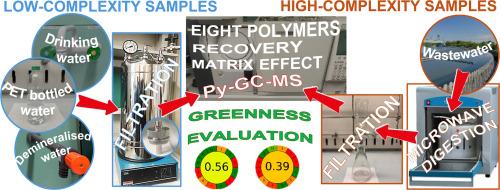Identification and quantification of microplastics in a wide range of aqueous matrices using pyrolysis-gas chromatography-mass spectrometry: method’s performance, greenness evaluation, and analysis of real samples
IF 6.2
引用次数: 0
Abstract
This study describes the analysis of microplastics in aqueous matrices of varying complexity using pyrolysis coupled with gas chromatography-mass spectrometry (Py-GC–MS). Depending on the filtration rate of the analysed matrix, sample treatment prior to Py-GC–MS consisted of filtration on 0.7 µm glass fibre membranes (low-complexity matrices), or microwave-assisted digestion of samples with hydrogen peroxide, followed by filtration as above-mentioned (high-complexity matrices). Low-complexity matrices included demineralised water (DMW), mineral water in polyethylene terephthalate (PET) bottles (BMW), drinking water from a public aqueduct (DW), and DW further treated with activated carbon and distributed in public fountains (FOW). High-complexity matrices included effluent wastewater from primary sedimentation (WW-PS), biological oxidation (WW-BO), clariflocculation (WW-CL), and quaternary treatment (WW-QT). Sample digestion significantly accelerated the filtration process of high-complexity matrices. In most cases, absolute value of matrix effect was <40 %, except for PET in WW-PS (-54 %) and WW-CL (-56 %), and polystyrene in WW-PS (75 %). Apparent recovery, studied in DMW, DW, and WW-BO matrices, was 90±24, 87±25, and 67±19, respectively. The methods were evaluated for their greenness, achieving scores higher than or comparable to those of previously published Py-GC–MS procedures. Poly(methyl methacrylate) and PET were never detected, while different levels of contamination were found for polystyrene, polyethylene, polypropylene, polycarbonate, polyamide, and polyvinyl chloride, depending on the sample type. The lowest contaminations were determined in BMW and DMW. FOW was more contaminated than DW (five microplastics detected at 2.7–138 µg/L vs. two microplastics detected at <0.62–23 µg/L) and concentrations in WWs were in the order WW-QT<WW-CL<WW-PS<<WW-BO.

用热解-气相色谱-质谱法鉴定和定量各种水基质中的微塑料:方法的性能、绿色评价和实际样品的分析
本研究描述了使用热解和气相色谱-质谱联用(Py-GC-MS)分析不同复杂程度的水基质中的微塑料。根据所分析基质的过滤速率,Py-GC-MS前的样品处理包括在0.7µm玻璃纤维膜上过滤(低复杂性基质),或用过氧化氢微波辅助消解样品,然后按照上述方法过滤(高复杂性基质)。低复杂性的基质包括脱盐水(DMW)、聚对苯二甲酸乙二醇酯(PET)瓶矿泉水(BMW)、公共水渠(DW)的饮用水,以及经过活性炭处理并分配到公共喷泉(FOW)的DW。高复杂性基质包括初沉出水(WW-PS)、生物氧化出水(WW-BO)、澄清絮凝出水(WW-CL)和四级处理出水(WW-QT)。样品消解显著加快了高复杂性基质的过滤过程。在大多数情况下,基质效应的绝对值为40%,除了PET在w - ps中(- 54%)和w - cl中(- 56%),聚苯乙烯在w - ps中(75%)。DMW、DW和WW-BO基质的表观回收率分别为90±24、87±25和67±19。对这些方法的绿色度进行了评估,其得分高于或与先前发表的Py-GC-MS程序相当。聚(甲基丙烯酸甲酯)和PET从未被检测到,而聚苯乙烯、聚乙烯、聚丙烯、聚碳酸酯、聚酰胺和聚氯乙烯的污染程度不同,具体取决于样品类型。BMW和DMW的污染最低。FOW比DW污染更严重(2.7-138µg/L检测到5个微塑料,<检测到2个微塑料;< 0.62-23µg/L), WWs中的浓度顺序为:WW-QT<;WW-CL<WW-PS<<WW-BO。
本文章由计算机程序翻译,如有差异,请以英文原文为准。
求助全文
约1分钟内获得全文
求助全文

 求助内容:
求助内容: 应助结果提醒方式:
应助结果提醒方式:


